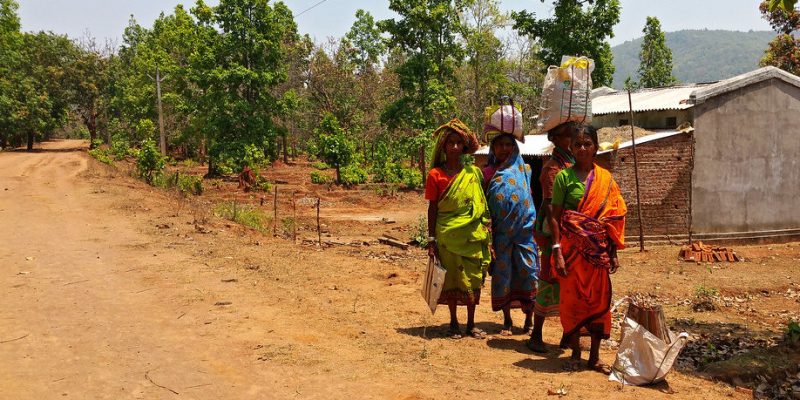The new year calls for a basic change in priorities – a need to focus on the development of rural areas. The current farmers’ agitation has thrown into sharp relief the failure of the government to understand the concerns of a large section of the rural population and their real needs and aspirations.
Over the years, various governments have spent large sums of money to improve conditions in rural areas without having had a serious impact. More recently, the prime minister himself initiated a number of projects for rural improvement, including schemes for building pucca houses, providing a toilet in every rural home, training youths in craft skills in rural areas, and a programme to provide jobs to migrants returning home. However, all of these schemes have failed to facilitate real change in the overall rural environment.
This is partly because all such projects have been arbitrarily implemented in bits and pieces, and to a large extent because of lack of planning, and clear vision of what our future villages should be. As a result, there has been minimal change and overall conditions remain abysmal. Planning for the villages has to be implemented on a hands-on basis with a focus on the problems of each individual village – something that cannot be done by politicians sitting in state capitals, or by bureaucrats who are not privy to rural issues and problems.
This is one of the main reasons why large numbers of unskilled migrants, who had lost their jobs, returned to their homes after the COVID-19-induced lockdown was imposed and are now once again considering returning to the marginally better conditions of life in the city.
Each state needs to focus on the planned future development of its rural areas. This needs an organised framework for the preparation of plans as well as an administrative structure for the control of future growth. Professional involvement is essential for the preparation of plans. Presently such matters are being handled by local politicians in league with the administrators, and this has disastrous implications. This is an issue that Niti Aayog, the central body responsible for planning, needs to address.
One of the major impediments to change in rural areas is the bureaucratic system that controls development. Over the years, various politicians have commented on the government’s administrative system and called for change, which has been strongly resisted by IAS officials.
Also read: IIM Ahmedabad’s Proposed Demolition Shows India’s Scant Regard for Architectural Wealth
In August 1973, Jayaprakash Narayan, then a member of the Indian National Congress, wrote an article about the government’s administrative system. His observations, which are still relevant today as the government’s mode of functioning has not changed over time, noted that the IAS was set up in accordance with the British framework for governing India, which was based on distrust, a system which still prevailed. He suggested that a work audit similar to a financial audit be introduced, along with a study of the working of the secretariat and administrative offices, in order to devise methods for the expeditious disposal of business.
Furthermore, it was pertinent that the chief minister and his colleagues regularly meet employees of the secretariat to discuss and solve their problems. Narayan said that the existing system of maximum wages for minimum work also had to be revamped. It was observed that half the employees of the secretariat did not work for more than two or three hours per day – something that had been observed by several chief ministers and senior officials. In order to deal with this issue, Narayan suggested the introduction of a system of work bonus to officers and lower level employees depending on performance.

Villagers use a makeshift bamboo bridge to move across flooded areas of Morigaon district in Assam. Photo: Reuters/Anuwar Hazarika
He drew attention to the fact that noting on files currently started at the lowest level and this should be stopped. No one below the lowest rank in the class of secretaries should be authorised to make notes on files. Lower-level notifications tend to create confusion and are used to manipulate decisions.
He also stressed on the fact that development administration was a specialised job. Presently, any secretary is often posted to do work of which the person had little or no understanding. Specialist advice was neither sought nor respected. Secretaries were freely transferred from one department to another on their way up. An agricultural secretary or a deputy secretary may get transferred after two years to become an education secretary or the secretary of industries.
This had all become a process of moving from one job to another, depending on political contacts. The entire system had become one of control and power, regardless of the nature of work and needed to be changed. It was suggested that specialised subjects or departments be divided into two groups, one where expertise could be acquired by a generalist, and the other where specialised knowledge and skill were essential.
Distrust of Indians led the British to form a highly centralised system of administration. As the demands for proper local administration had grown this system caused needless delays and interference. It would therefore be better to re-organise the entire bureaucratic system to make it more effective. Narayan suggested the establishment of separate autonomous organisations to deal with specialised issues like agriculture and industries.
He drew attention to the fact that strong action would be needed to implement changes as the ICS and IAS would not allow truly autonomous bodies to emerge and function.
These observations are still very relevant today.
Also read: Central Vista Project Will Cement Bureaucratic System That Badly Needs Revamping
Over the years other senior government officials also called for the administrative system to be re-organised, but other than the separation of control in the Atomic Energy Commission, and the Indian Space Research Organisation, the basic system of the administration still remains the same.
On November 18, 2018, during a lecture at IIM Ahmedabad, former President Pranab Mukherjee, a politician with five decades of experience in several ministerial positions, said that bureaucracy remained the biggest obstacle to the nation’s development and must be rectified. The world was changing very fast and we would need to keep abreast of this change, adjust ourselves, adapt ourselves, and be flexible so that we may formulate and articulate our policies accordingly. No system in the world can function without appropriate institutional mechanisms. Mukherjee said the civil services would often find ways and make excuses to obstruct development.
It is interesting that despite these serious evaluations, we remain stuck in a quagmire. Prime Minister Modi, after taking office six years ago, visited several government offices and insisted that the staff and officials come on time, and leave only after completing a full day’s work. His observations brought about change for a short period of time, but since the system of control was not changed, conditions soon returned to what they were before.
What is more surprising is the fact that the prime minister has even now not taken serious note of the rapid changes taking place in technological development. On one hand, he professes to be well aware of changes in the world of artificial intelligence and the need for planning based on futuristic concepts, yet on the other hand, he persists in pushing through projects based on an approach that will soon be out-dated. The Central Vista is one such example of colossal public expenditure on a project based on an out-dated office concept, which, despite public protest, is being rammed through.
The proposal to build a series of ten-storey high government secretariats along both sides of the Rajpath connected by an underground metro rail system calls for the concentration of over 70,000 workers within limited confines and flies in the face of the realities exposed by the current pandemic. The current COVID-19 pandemic has called into question working and living conditions and has highlighted the need for an approach to urban planning that affords adequate space for people to move about without close contact.

Windows of various shanties in Dharavi, one of Asia’s largest slums, are seen in Mumbai January 28, 2015. Photo: Danish Siddiqui/Reuters/Files
Working from home has shown itself to be a feasible alternative option for some office workers, eliminating the need to travel long distances to their place of work. Other options include working from local work centres suitably located across the city, all connected by the internet to central offices which may be visited only occasionally for meetings. With such changes, all large multi-storey office complexes will become obsolete and crowded and concentrated urban work centres will be eliminated.
With such possibilities being imminent, the proposal to build all the government secretariats in one location, with the massive expenditure of public funds involved, and the destruction of public space in the national capital, is positively wasteful, and short-sighted. Little attention has been drawn to a large number of office complexes for different ministries built over recent years in different parts of the city, all of which will become redundant if the Central Vista proposals are implemented.
Also read: How Urbanisation Went Wrong in Delhi’s Lal Dora Villages
It is amazing that an organisation like Niti Aayog, on one hand, acknowledges the importance of developing new technologies like solar and wind power, and the creation of large scale power storage facilities with new chemical storage batteries, and the need for an internet connection to each and every home, is still so obtuse when it comes to visualising future urban development. They are still citing the development of skyscraper offices as in Shanghai and South Korea as symbols for future growth, whose success is doubtful and alien to our way of life and living conditions. These images, however, fascinate Niti Aayog, which seems to be totally oblivious to the need for sensitive planning in our rural areas where a majority of our population still lives. They believe that cities and large urban developments are the elements of future growth where the bulk of our population will live and work, so the rural areas may continue to be ignored.
With the return of large numbers of unskilled workers from cities to their homes in rural areas, the current situation requires a change of approach and the need to focus on the proper development of our large rural hinterland and small towns. This calls for the active involvement of professionals like architects, urban designers, landscape architects, and environmental experts on an organised basis. To date, no plans have been prepared for the growth and development of our large number of villages and small towns. This now needs urgent attention. It would be good if the Niti Aayog were to focus on this issue and help the government set up a cadre of trained professionals responsible for the detailed development of rural areas in each and every state.
In order to establish a separate new rural administrative system, the government will have to over-ride the resistance posed by IAS officials to the setting up of an independent service system. But such a change is now essential and urgently called for. The present system where IAS officers are in control of the development of rural areas, and who have no understanding of the specific issues and problems involved, has proved to be ineffective. A cadre of officials specially trained to understand different aspects of rural issues, along with a team of professionals responsible for future planning, would help bring about a change and improvement of life in these areas.
Currently, conditions in rural areas in large parts of our country are abysmal. It is common to see pictures of villages with houses crowded along narrow lanes with sewage and stormwater flowing alongside. There are no open spaces or meeting areas other than those on the outer fringes of the village, or in residential courtyards. The schools and health centres are also developed in isolated pockets. The type and size of dwelling units are still largely based on the caste and traditional hierarchy of the occupants.
Conditions, however, are not static. Change is being brought about despite conflicts on many issues. It is common now to see every young villager with a cell phone. Those who are more confident and familiar with the use of computers with access to the internet are aware of events across the world. These changes are not because of schools or educational institutions but are the result of a process of self-education. Such motivated youths should be mobilised, trained and made aware of the need for rural improvement and development.
Apart from providing an internet connection in every rural home, the improvement and growth of individual villages needs to be structured on a futuristic basis of rapid change. Necessary training facilities including computer training centres need to be developed as an integral part of education in rural schools.
Also read: The Council of Architecture Needs to Honour its Commitment to the Profession
At present, there is no systematic planning of rural areas in states and virtually no site plans are available. For the proper planning of the rural areas aerial surveys need to be carried out, and plans prepared showing existing structures, connecting roads and footpaths, location of waterways, streams, and natural drainage channels, areas of forests, delineation of individual farm areas, along with the topography and change in level.
The existing traffic connections to nearby towns and cities need to be clearly indicated as well as the available bus and rail connections. Based on detailed information, development plans may then be prepared for the improvement of each individual village showing the location for the proposed schools, health centres, meeting places, playgrounds for children, rural administration offices, police stations, and local shopping centres.
Depending on location, a small town in the region may become a focal point for the surrounding rural areas where facilities for the trading of agricultural products, mandis, warehouses, and cold storage facilities may be developed. Along with this, there could be centres for the sale of agricultural machinery, tractors, harvesters, etc. with the necessary support facilities for repair and maintenance. Suitably connected regional centres could also be planned to have colleges, specialised skill training centres, speciality hospitals, and an agricultural university.

An APMC mandi at Gariyaband in Chhattisgarh. Photo: Neeraj Mishra
In the absence of plans, a lot of development is currently occurring on a haphazard basis, without proper consideration of the suitability of the location of the facility involved. Big companies are buying up tracts of land to set up structures for storing grain, fruits, and cold storage units, on an ad hoc basis. This is all part of the process of privatisation that the government is encouraging without the preparation of proper development plans.
In order to prevent this kind of chaotic development, the system needs to be refurbished, with proper plans prepared by trained architects, planners, urban designers, and landscape architects. There is no shortage of qualified professionals in the country – which is not recognised and taken advantage of nearly enough. There are, at present, 149,000 qualified architects all concentrated in large towns and cities. Thirty thousand new students graduate every year who could be actively involved in the development of our vast rural hinterland which needs proper planning. The concentration of qualified professionals in cities in every state calls for dispersal so that development skills are more widely available.
The COVID-19 pandemic has highlighted the need for change. It has become necessary to move people away from crowded workplaces and cramped living conditions. Development is currently based on the monetisation of land where the wealthy minority occupy vast tracts of land, and the poorer sections of society live in congested conditions.
We need to plan on a more equitable basis and make a conscious effort to release the stranglehold on land that politicians, developers, and administrators have created. Cities with a concentration of intense development will no longer be the generators of wealth. The future calls for low rise communities developed in tune with nature, where each resident has access to open spaces, parks, playgrounds and community facilities. This calls for a lighter footprint on the land, which can be successfully achieved with proper planning for the future growth of our vast rural hinterland.
The article by Jayaprakash Narayan was shared by S.S. Kaimal, former Chief Technical Adviser to the UN and Chief Engineer of the Government of India.
Ranjit Sabikhi is an architect and urban designer. He was formerly Professor of Urban Design at the School of Planning & Architecture, Delhi.




